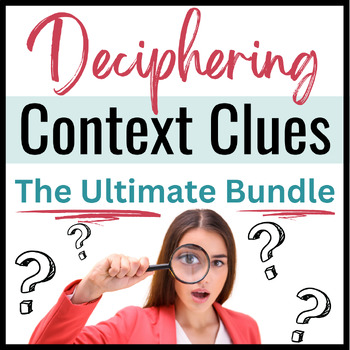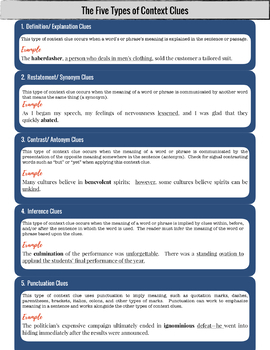Context Clues Vocabulary Bundle- SAT + Close Reading Practice for ELA
- Zip
What educators are saying
Description
This bundle targets the five different types of context clues: definition, synonym, antonym, inference, and punctuation. Students will practice each type of context clue using SAT-style sentence completions. They will then complete a close reading of The Declaration of Independence plus a close reading of an excerpt from the novel Middlemarch using context clues to decipher the meaning of unknown words and phrases.
Here is what is included in this bundle:
- Teacher Page
- Types of Context Clues Doodle Notes
- Context Clues Power Point
- Definition/ Explanation Clues— Practice
- Restatement/ Synonym Clues Practice
- Contrast/ Antonym Clues— Practice
- Inference Context Clues— Practice
- Punctuation Context Clues— Practice
- Reading Strategy: Identifying as Positive, Negative, or Neutral
- Context Clues Close Reading Passage #1
- Student Sample
- Context Clues Close Reading Passage #2
- Student Sample
- SAT Context Clues Practice
- Context Clues Group Challenge
- SAT Word List
- Context Clues Bookmarks
This bundle is a great way to target the following standards and skills:
Common Core Standards
R1, 4-5, 10-11 L 4, 6
Learning Targets
- To decipher the tone of unknown words
- To use context clues to decipher new vocabulary words
- To practice SAT sentence completion questions
- To use context clues to apply process of elimination
- To close read nonfiction and literary passages with context clues to decipher new words
Students can use these skills throughout the year to help them decipher the meaning of new words in context.
PERKS FOR YOU
*Join the Bespoke ELA Blog to gain access to 100+ FREE resources that are not here on TpT!
* Be sure to click the "FOLLOW" button that is located next to my picture in the profile so that you can hear about sales, new products, and freebies!
* Don't forget to leave feedback to EARN POINTS that turn into cash towards future purchases!
=============================
You might also like:
The ULTIMATE Shakespeare Sonnet Bundle-- 100+ Pages and 15 Sonnets
Winter Poetry Unit with Annotations, Sample Explication Essays, & MORE!
Imagists vs. Romantics: A Poetry Lesson to Facilitate Style Analysis
30 MENTOR SENTENCES for Literary & Rhetorical Devices with Writing Application
=============================
Follow ME for UPDATES, ANNOUNCEMENTS, & FREEBIES





